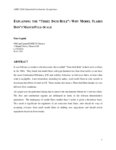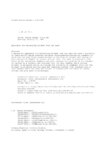TO
Filters: Collection: "ir_eua"
| Title | Date | Subject | Description | ||
|---|---|---|---|---|---|
| 1 |
 |
Fischer Assay Data, Utah Geological Survey Well Number U498 | 2008 | This dataset contains the results of Fischer assay analyses obtained and published by the Utah Geological Survey for well U498. | |
| 2 |
 |
Method for controlling sand in thermal recovery of oil from tar sands | 1978-09-19 | controlling sand; thermal recovery of oil; tar sands oil recovery; tar sands; oil recovery; patent; oil production | A method is disclosed for producing oil from a subterranean reservoir of tar sands as unconsolidated oil bearing sands. The method comprises basically (1) setting a screen in an open hole, the screen being large enough to pass a majority of the formation sand and small enough to retain a packing mat... |
| 3 |
 |
Explaining the "three inch rule": why model flares don't match full-scale | 2022 | It was Pohl and co-workers who discovered the so-called "Three Inch Rule" in their work on flares in the 1980s. They found that model flares with pipe diameter less than three inches do not have the same Combustion Efficiency (CE) and stability behaviour as full-scale flares, at least when wind is n... | |
| 4 |
 |
Apparatus for extracting bitumen from tar sand | 1982-01-19 | Patent; Extracting bitumen from tar sand; Extraction chambers; Countercurrent flow; Plurality; Individually sealed pressure adjusted interconnected extraction chambers in series; Tar sand; Bitumen | A method and apparatus for extracting bitumen from tar sand utilizes a plurality of individually sealed pressure adjusted interconnected extraction chambers in which the tar sand flows countercurrent to the flow of solvent with mixing in each extraction chamber of solvent and tar sand. Tar sand is p... |
| 5 |
 |
Chapter 10 | |||
| 6 |
 |
Method of extracting liquid and gaseous fuel from oil shale and tar sand | 1981-05-12 | liquid extraction; gaseous fuel; oil shale; tar sand; patent | Kerogen and other combustible matter can be extracted from an area of oil shale or tarsand by drilling boreholes in a selected pattern through the overlying soil and rock without removing it. Each borehole mouth is tightly closed by a cover provided with an air inlet pipe and a gas exhaust pipe. In ... |
| 7 |
 |
Attrition and abrasion models for oil shale process modeling | 1991-10-25 | As oil shale is processed, line particles, much smaller than the original shale are created. This process is called attrition or more accurately abrasion. In this paper, models of abrasion are presented for oil shale being processed in several unit operations. Two of these unit operations, a fluidiz... | |
| 8 |
 |
Method of recovering viscous petroleum from tar sand | 1976-11-30 | Patent; Viscous petroleum recovery; Tar sands | Recovery of viscous petroleum such as from tar sands is assisted using a substantially vertical passage from the earth's surface which penetrates the tar sand and has extending therefrom a lateral hole containing a flow path isolated from the tar sand for circulating a hot fluid to and from the vert... |
| 9 |
 |
Lawrence Livermore National Laboratory oil shale project (Nov 1983) | 1983-11 | oil shale; pyrolysis on sulfer gases; nitric oxide formation; sulfur gas production | I. Effect of Pyrolysis Conditions on Sulfur Gases. II. Nitric Oxide Formation During Combustion. III Process Modeling. |
| 10 |
 |
KTIA corporate introduction | 2009-02-27 | KTIA; KTI; mines | Overview of KTIA's continuing oil sands development activities in Utah, presented at the 2009 Western U.S. Oil Sands Conference by Soung-Joon Kim, Chief Operating Officer, Korea Technology Industry America, Inc. |
| 11 |
 |
Results of mathematical modeling of an oil shale retort having a fluidized-bed pyrolyzer and a lift-pipe combustor | 1988-01 | mathematical modeling; oil shale retort; fluidezed-bed pyrolyzer; lift-pipe combustior; varying key process parameters | Many aboveground processes have been proposed for retorting oil shale. The common objective is to heat oil shale particles to 450-600°C to pyrolyze the kerogen in the shale and form oil. Either hot gas or hot solid particles may be used to supply heat to the shale. Hot-solids processes heat the coo... |
| 12 |
 |
Oil shale quarterly report | 1990-09-05 | Aboveground oil shale retorting; Hot-Recycled-Solid; HRS; Pyrolysis; Lawrence Livermore National Laboratory | We are studying aboveground oil shale retorting and have developed the LLNL Hot-Recycled-Solid (HRS) process as a generic, second-generation, rapid pyrolysis retorting system in which recycled shale is the solid heat carrier. In 1984-87, we operated a 1-tonne-per-day FIRS pilot plant to study retort... |
| 13 |
 |
Apparatus for separating organic material from particulate tar sands and coal and agglomeration of the particulate residue | 1976-10-05 | Patent; Tar sands; Coal; Agglomeration of particle residue; Agglomerating liquid; Immiscible; Varsol; Ball agglomerates | A rotatable drum having an interior which tapers in a horizontal direction has a first port at the smaller end for receiving particulate Tar Sands or coal, and an agglomerating liquid, e.g. water, and a second port at the larger end for receiving an organic material separating liquid, e.g. Varsol, w... |
| 14 |
 |
Results of mathematical modeling of an oil shale retort having a fluidized-bed pyrolyzer and a lift-pipe combustor | 1988-10 | Mathematical modeling; oil shale retort; fluidized-bed pyrolyzer; lift-pipe combustor; computer model | A commercial-size, hot-solids recycle retorting process, consisting of a staged fluidized-bed pyrolyzer and a lift-pipe combustor, was simulated using a previously developed mathematical model. The focus of this work at Lawrence Livermore National Laboratory (LLNL) is to show the effects of varying ... |
| 15 |
 |
Oil shale retorting processes: A technical overview | 1984-03 | The challenge facing the oil shale industry is to devise a simple and efficient retorting process that operates at low cost. This will require a thorough understanding of the important physical and chemical processes that occur during retorting, mathematical modeling to analyze the complex interacti... | |
| 16 |
 |
The extraction of bitumen from western oil sands: Volume 2 | 1997-11-26 | bitumen extraction; western oil sands; oil sands; synthetic fuels; natural bitumen; thermally-coupled fluidized-bed tar sands extraction process | In these days of plentiful fuel supplies, synthetic fuels are not in demand; but with the current rate of consumption of oil the importance of synthetic fuels will only increase. The United States currently imports 50% of its transportation fuel and such a dependence could be potentially dangerous, ... |
| 17 |
 |
Computational study of the anode baking industrial furnace | Turbulent flow; Eddy dissipation model; Combustion, NOx; Zeldovich mechanism | In the aluminium industry, the Hall-Héroult process is used for smelting of aluminium using carbon electrodes such as anodes. The baking process of anodes is required for their maximum efficiency during this electrolysis process. The anode baking process contributes up to 15% costs in the aluminium... | |
| 18 |
 |
Recovering viscous petroleum from thick tar sand | 1976-11-30 | viscous petroleum recovery; thick tar sands; in situ | Recovery of viscous petroleum such as from thick tar sands is assisted using a closed-loop flow path from the earth's surface through a substantial portion of the formation for conducting hot fluid to reduce the viscosity of the petroleum in the formation to develop a potential passage in the format... |
| 19 |
 |
Lawrence Livermore National Laboratory oil shale project (Jun 1987) | 1987-06 | isomerization of alkenes; shale oil by kaolinite; oil shale enthalpy relations; fluid-bed pyrolzer; retorting; oil shale | I. Isomerization of Alkenes in the Shale Oil by Kaolinite. II. Oil Shale Enthalpy Relations. III. Simulation of Fluid-bed Pyrolzer/Lift-pipe Combustor Retort. IV. Yields from the Cross-swept, Packed-bed Pyrolzer Depend on Sweep, Run Conditions, and Shale Type |
| 20 |
 |
Scientific drilling: Directional drilling in coal | 2011-03-21 | scientific drilling; directional drilling in coal; drilling; UCG training course; UCG | UCG Training Course, March 21-22, 2011, Deloitte, London |
| 21 |
 |
Lawrence Livermore National Laboratory oil shale project (Jun 1984) | 1984-06 | oil shale processing; solids-recycle retort system; sulfur gas analysis; oil shale; sulfur and nitrogen in oil shale; above ground retorting | I. Sulfur and Nitrogen in Oil Shale Processing. II Initial Operation of the Solids-Recycle Retort System. III. Sulfur Gas Analysis by Triple Quadruple Mass Spectrometry. IV. Retort Modeling. V. Publications and Presentations. VI. Visitors. |
| 22 |
 |
Recovery of bitumen from tar sands by a thermally coupled fluidized-bed process | 1985-07 | bitumen recovery; tar sands; thermally coupled fluidized-bed process; tar sands; biomass; heavy oil; oil shale; coal; bitumen deposits; synfuel industry; hydrocarbon recovery | Tar sands, biomass, heavy oil, oil shale, and coal are considered to be the primary contributors to the emerging synfuel industry. On a global basis, Meyer and Fulton (1982) estimate the total heavy oil and bitumen resource to be more than 4 trillion barrels, with in-place reserves estimated at 671 ... |
| 23 |
 |
Treatment of primary tailings and middlings from the hot water extraction process for recovering bitumen from tar sand | 1985-10-08 | primary tailing treatment; primary middling treatment; hot water extraction process; bitumen recovery; tar sand | The primary tailings and middlings are combined and fed to a vessel having the general form of a deep cone thickener. The feed is deflected outwardly and generally horizontally by a baffle, as it is delivered to the vessel. Simultaneously, the outwardly radiating layer of newly added feed is contact... |
| 24 |
 |
Coring and testing wells Asphalt Ridge, Utah | 1957-10-21 | A second well was cored and some injection and production tests were made using this well and the well that already existed on Gulf's Palmer lease at Asphalt Ridge, Utah. The formation that has been tested is the Duchesne River, which is more lenticular and erratic than the Mesa Verde which contains... | |
| 25 |
 |
Appendix |
